BUS202 Applied Macroeconomics Semester 2: Problem Set 4 Solution
VerifiedAdded on 2020/03/16
|6
|1295
|38
Homework Assignment
AI Summary
This document presents a comprehensive solution to a macroeconomics problem set (Assessment Task 1, Problem Set 4) for the BUS202 course. The problem set explores the IS-LM model, analyzing the effects of monetary policy on output and interest rates, and the implications of these policies under a floating exchange rate regime, considering both perfect and imperfect capital mobility. The solution details how a contractionary monetary policy impacts the LM curve, exchange rates, and net exports, illustrating these changes graphically. Furthermore, the assignment delves into the LM schedule, deriving its slope and examining conditions under which it becomes flat, relating these conditions to the elasticities of money demand. Finally, it investigates the concept of crowding out and the effectiveness of fiscal policy when the LM schedule is flat, explaining the interaction between the goods and money markets and demonstrating the impact of fiscal policy on GDP and interest rates, with accompanying diagrams to illustrate the concepts. The solution references various academic sources to support the analysis.
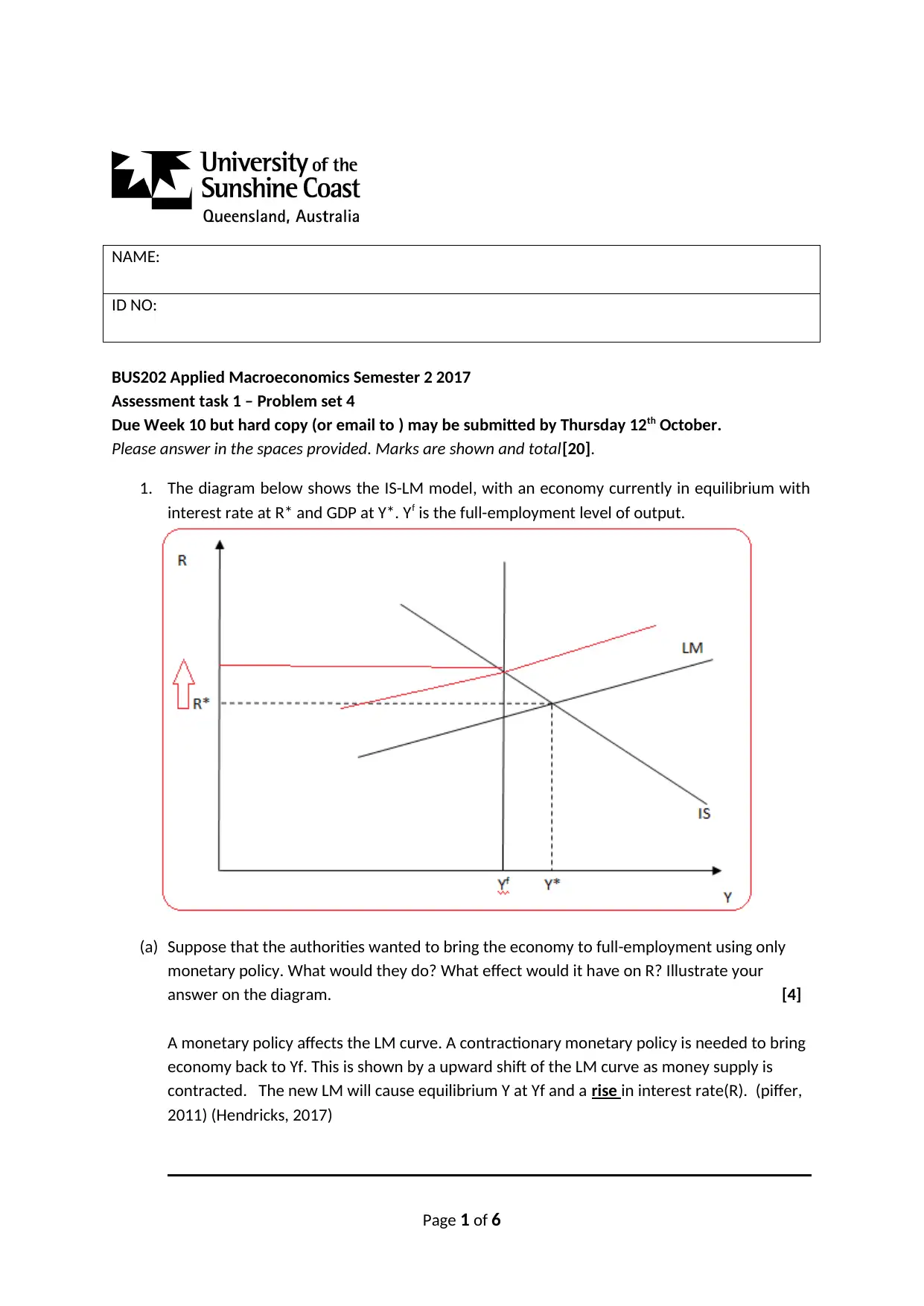
NAME:
ID NO:
BUS202 Applied Macroeconomics Semester 2 2017
Assessment task 1 – Problem set 4
Due Week 10 but hard copy (or email to ) may be submitted by Thursday 12th October.
Please answer in the spaces provided. Marks are shown and total[20].
1. The diagram below shows the IS-LM model, with an economy currently in equilibrium with
interest rate at R* and GDP at Y*. Yf is the full-employment level of output.
(a) Suppose that the authorities wanted to bring the economy to full-employment using only
monetary policy. What would they do? What effect would it have on R? Illustrate your
answer on the diagram. [4]
A monetary policy affects the LM curve. A contractionary monetary policy is needed to bring
economy back to Yf. This is shown by a upward shift of the LM curve as money supply is
contracted. The new LM will cause equilibrium Y at Yf and a rise in interest rate(R). (piffer,
2011) (Hendricks, 2017)
Page 1 of 6
ID NO:
BUS202 Applied Macroeconomics Semester 2 2017
Assessment task 1 – Problem set 4
Due Week 10 but hard copy (or email to ) may be submitted by Thursday 12th October.
Please answer in the spaces provided. Marks are shown and total[20].
1. The diagram below shows the IS-LM model, with an economy currently in equilibrium with
interest rate at R* and GDP at Y*. Yf is the full-employment level of output.
(a) Suppose that the authorities wanted to bring the economy to full-employment using only
monetary policy. What would they do? What effect would it have on R? Illustrate your
answer on the diagram. [4]
A monetary policy affects the LM curve. A contractionary monetary policy is needed to bring
economy back to Yf. This is shown by a upward shift of the LM curve as money supply is
contracted. The new LM will cause equilibrium Y at Yf and a rise in interest rate(R). (piffer,
2011) (Hendricks, 2017)
Page 1 of 6
Paraphrase This Document
Need a fresh take? Get an instant paraphrase of this document with our AI Paraphraser
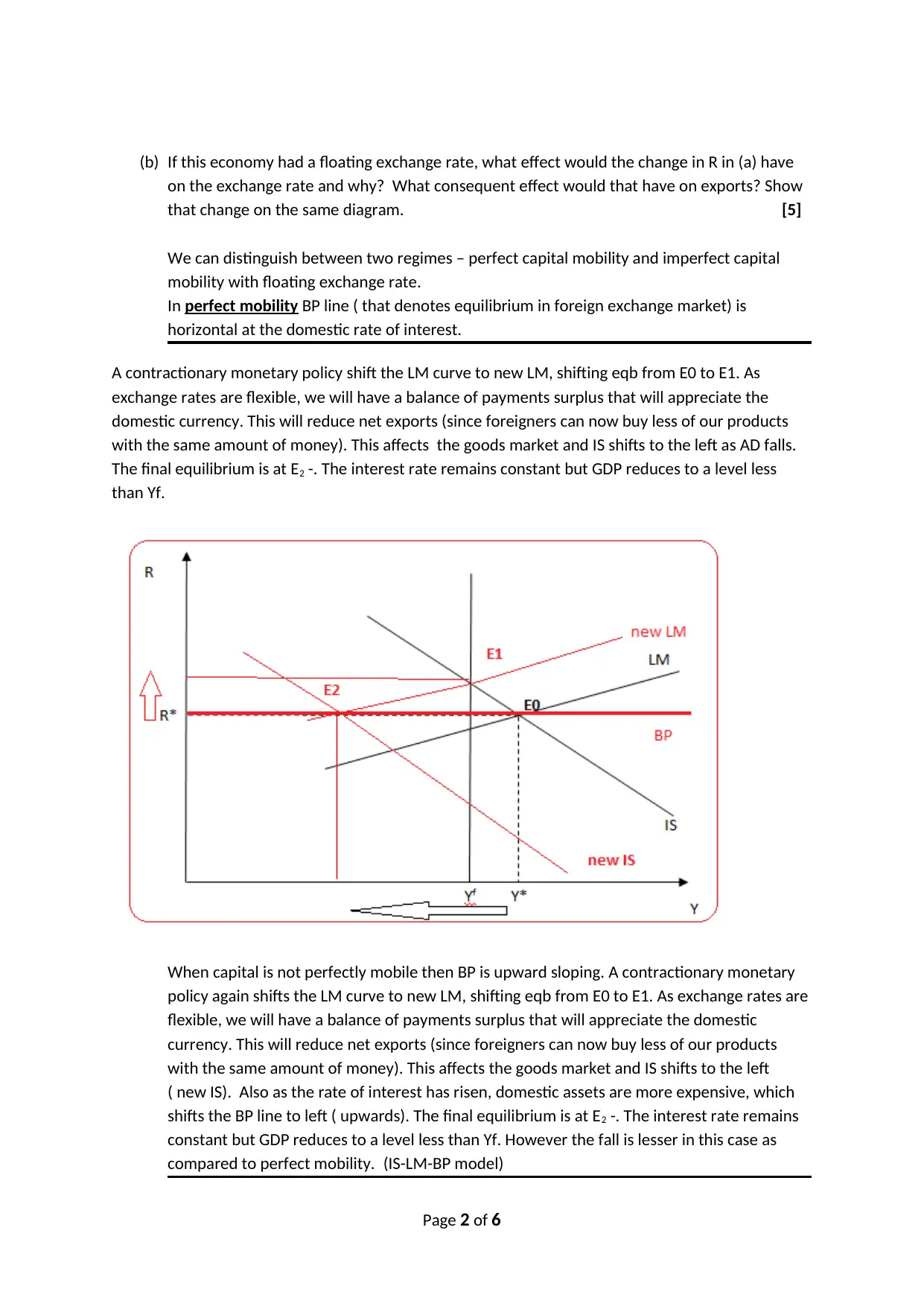
(b) If this economy had a floating exchange rate, what effect would the change in R in (a) have
on the exchange rate and why? What consequent effect would that have on exports? Show
that change on the same diagram. [5]
We can distinguish between two regimes – perfect capital mobility and imperfect capital
mobility with floating exchange rate.
In perfect mobility BP line ( that denotes equilibrium in foreign exchange market) is
horizontal at the domestic rate of interest.
A contractionary monetary policy shift the LM curve to new LM, shifting eqb from E0 to E1. As
exchange rates are flexible, we will have a balance of payments surplus that will appreciate the
domestic currency. This will reduce net exports (since foreigners can now buy less of our products
with the same amount of money). This affects the goods market and IS shifts to the left as AD falls.
The final equilibrium is at E2 -. The interest rate remains constant but GDP reduces to a level less
than Yf.
When capital is not perfectly mobile then BP is upward sloping. A contractionary monetary
policy again shifts the LM curve to new LM, shifting eqb from E0 to E1. As exchange rates are
flexible, we will have a balance of payments surplus that will appreciate the domestic
currency. This will reduce net exports (since foreigners can now buy less of our products
with the same amount of money). This affects the goods market and IS shifts to the left
( new IS). Also as the rate of interest has risen, domestic assets are more expensive, which
shifts the BP line to left ( upwards). The final equilibrium is at E2 -. The interest rate remains
constant but GDP reduces to a level less than Yf. However the fall is lesser in this case as
compared to perfect mobility. (IS-LM-BP model)
Page 2 of 6
on the exchange rate and why? What consequent effect would that have on exports? Show
that change on the same diagram. [5]
We can distinguish between two regimes – perfect capital mobility and imperfect capital
mobility with floating exchange rate.
In perfect mobility BP line ( that denotes equilibrium in foreign exchange market) is
horizontal at the domestic rate of interest.
A contractionary monetary policy shift the LM curve to new LM, shifting eqb from E0 to E1. As
exchange rates are flexible, we will have a balance of payments surplus that will appreciate the
domestic currency. This will reduce net exports (since foreigners can now buy less of our products
with the same amount of money). This affects the goods market and IS shifts to the left as AD falls.
The final equilibrium is at E2 -. The interest rate remains constant but GDP reduces to a level less
than Yf.
When capital is not perfectly mobile then BP is upward sloping. A contractionary monetary
policy again shifts the LM curve to new LM, shifting eqb from E0 to E1. As exchange rates are
flexible, we will have a balance of payments surplus that will appreciate the domestic
currency. This will reduce net exports (since foreigners can now buy less of our products
with the same amount of money). This affects the goods market and IS shifts to the left
( new IS). Also as the rate of interest has risen, domestic assets are more expensive, which
shifts the BP line to left ( upwards). The final equilibrium is at E2 -. The interest rate remains
constant but GDP reduces to a level less than Yf. However the fall is lesser in this case as
compared to perfect mobility. (IS-LM-BP model)
Page 2 of 6
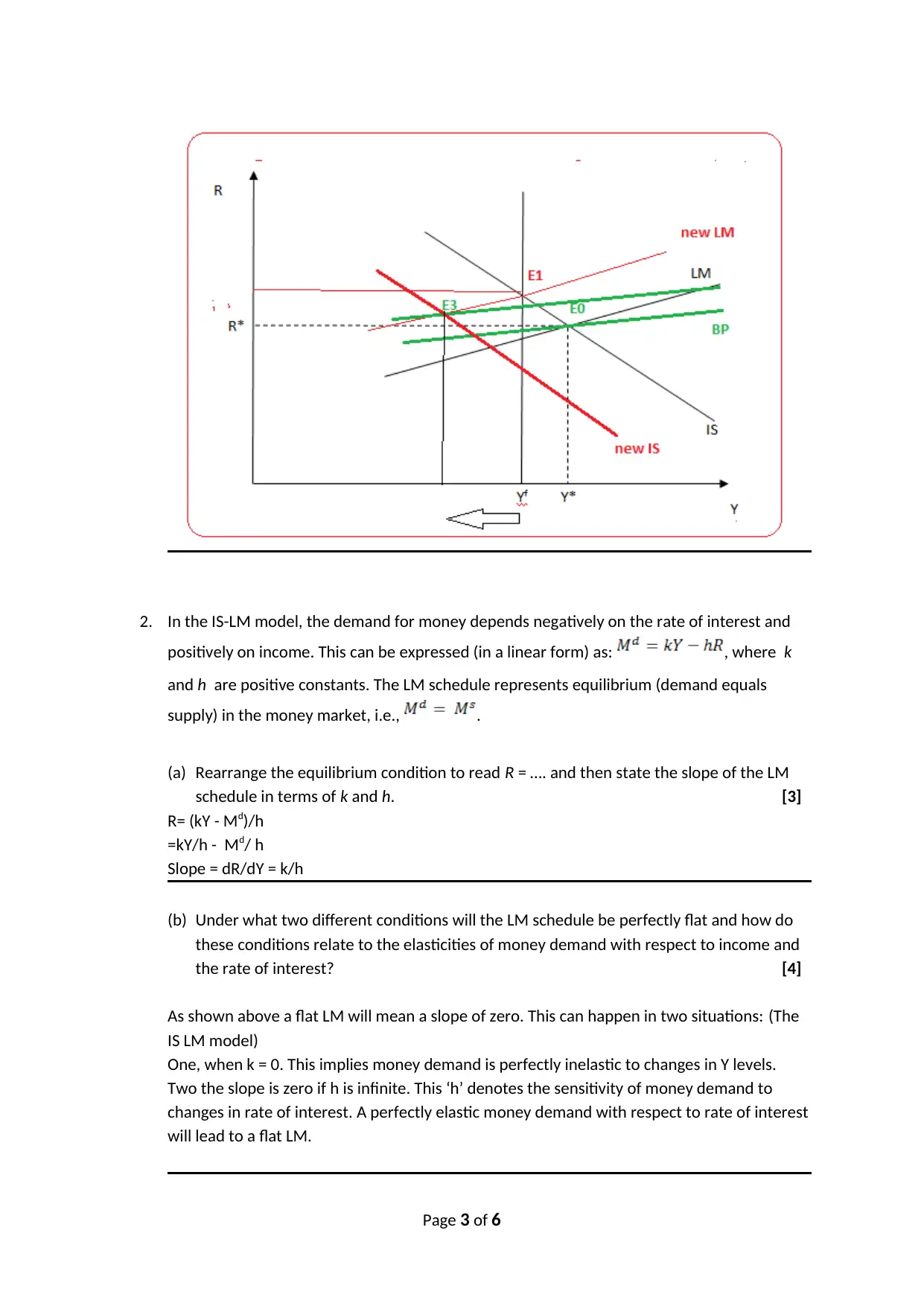
2. In the IS-LM model, the demand for money depends negatively on the rate of interest and
positively on income. This can be expressed (in a linear form) as: , where k
and h are positive constants. The LM schedule represents equilibrium (demand equals
supply) in the money market, i.e., .
(a) Rearrange the equilibrium condition to read R = …. and then state the slope of the LM
schedule in terms of k and h. [3]
R= (kY - Md)/h
=kY/h - Md/ h
Slope = dR/dY = k/h
(b) Under what two different conditions will the LM schedule be perfectly flat and how do
these conditions relate to the elasticities of money demand with respect to income and
the rate of interest? [4]
As shown above a flat LM will mean a slope of zero. This can happen in two situations: (The
IS LM model)
One, when k = 0. This implies money demand is perfectly inelastic to changes in Y levels.
Two the slope is zero if h is infinite. This ‘h’ denotes the sensitivity of money demand to
changes in rate of interest. A perfectly elastic money demand with respect to rate of interest
will lead to a flat LM.
Page 3 of 6
positively on income. This can be expressed (in a linear form) as: , where k
and h are positive constants. The LM schedule represents equilibrium (demand equals
supply) in the money market, i.e., .
(a) Rearrange the equilibrium condition to read R = …. and then state the slope of the LM
schedule in terms of k and h. [3]
R= (kY - Md)/h
=kY/h - Md/ h
Slope = dR/dY = k/h
(b) Under what two different conditions will the LM schedule be perfectly flat and how do
these conditions relate to the elasticities of money demand with respect to income and
the rate of interest? [4]
As shown above a flat LM will mean a slope of zero. This can happen in two situations: (The
IS LM model)
One, when k = 0. This implies money demand is perfectly inelastic to changes in Y levels.
Two the slope is zero if h is infinite. This ‘h’ denotes the sensitivity of money demand to
changes in rate of interest. A perfectly elastic money demand with respect to rate of interest
will lead to a flat LM.
Page 3 of 6
⊘ This is a preview!⊘
Do you want full access?
Subscribe today to unlock all pages.

Trusted by 1+ million students worldwide
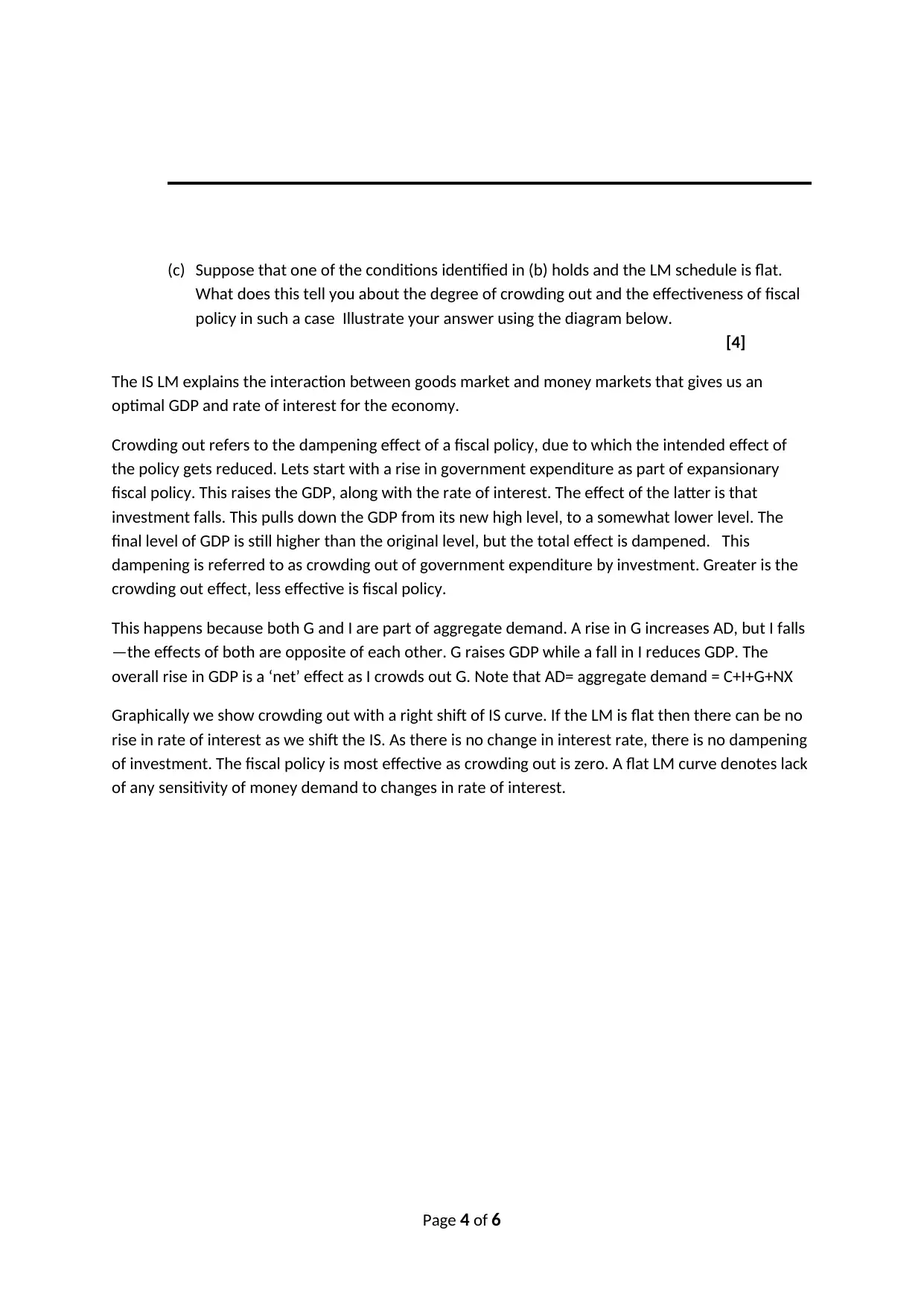
(c) Suppose that one of the conditions identified in (b) holds and the LM schedule is flat.
What does this tell you about the degree of crowding out and the effectiveness of fiscal
policy in such a case Illustrate your answer using the diagram below.
[4]
The IS LM explains the interaction between goods market and money markets that gives us an
optimal GDP and rate of interest for the economy.
Crowding out refers to the dampening effect of a fiscal policy, due to which the intended effect of
the policy gets reduced. Lets start with a rise in government expenditure as part of expansionary
fiscal policy. This raises the GDP, along with the rate of interest. The effect of the latter is that
investment falls. This pulls down the GDP from its new high level, to a somewhat lower level. The
final level of GDP is still higher than the original level, but the total effect is dampened. This
dampening is referred to as crowding out of government expenditure by investment. Greater is the
crowding out effect, less effective is fiscal policy.
This happens because both G and I are part of aggregate demand. A rise in G increases AD, but I falls
—the effects of both are opposite of each other. G raises GDP while a fall in I reduces GDP. The
overall rise in GDP is a ‘net’ effect as I crowds out G. Note that AD= aggregate demand = C+I+G+NX
Graphically we show crowding out with a right shift of IS curve. If the LM is flat then there can be no
rise in rate of interest as we shift the IS. As there is no change in interest rate, there is no dampening
of investment. The fiscal policy is most effective as crowding out is zero. A flat LM curve denotes lack
of any sensitivity of money demand to changes in rate of interest.
Page 4 of 6
What does this tell you about the degree of crowding out and the effectiveness of fiscal
policy in such a case Illustrate your answer using the diagram below.
[4]
The IS LM explains the interaction between goods market and money markets that gives us an
optimal GDP and rate of interest for the economy.
Crowding out refers to the dampening effect of a fiscal policy, due to which the intended effect of
the policy gets reduced. Lets start with a rise in government expenditure as part of expansionary
fiscal policy. This raises the GDP, along with the rate of interest. The effect of the latter is that
investment falls. This pulls down the GDP from its new high level, to a somewhat lower level. The
final level of GDP is still higher than the original level, but the total effect is dampened. This
dampening is referred to as crowding out of government expenditure by investment. Greater is the
crowding out effect, less effective is fiscal policy.
This happens because both G and I are part of aggregate demand. A rise in G increases AD, but I falls
—the effects of both are opposite of each other. G raises GDP while a fall in I reduces GDP. The
overall rise in GDP is a ‘net’ effect as I crowds out G. Note that AD= aggregate demand = C+I+G+NX
Graphically we show crowding out with a right shift of IS curve. If the LM is flat then there can be no
rise in rate of interest as we shift the IS. As there is no change in interest rate, there is no dampening
of investment. The fiscal policy is most effective as crowding out is zero. A flat LM curve denotes lack
of any sensitivity of money demand to changes in rate of interest.
Page 4 of 6
Paraphrase This Document
Need a fresh take? Get an instant paraphrase of this document with our AI Paraphraser
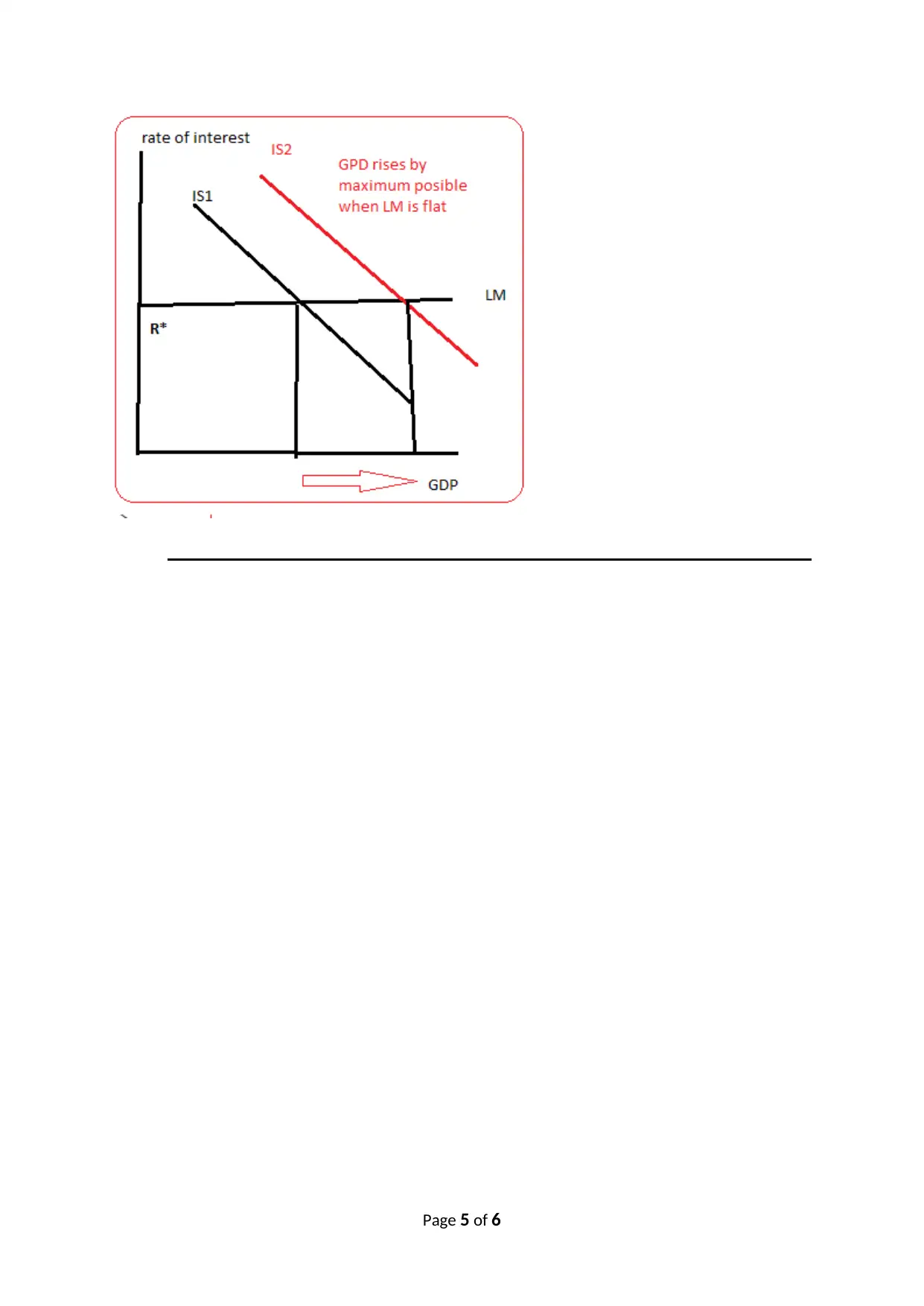
Page 5 of 6
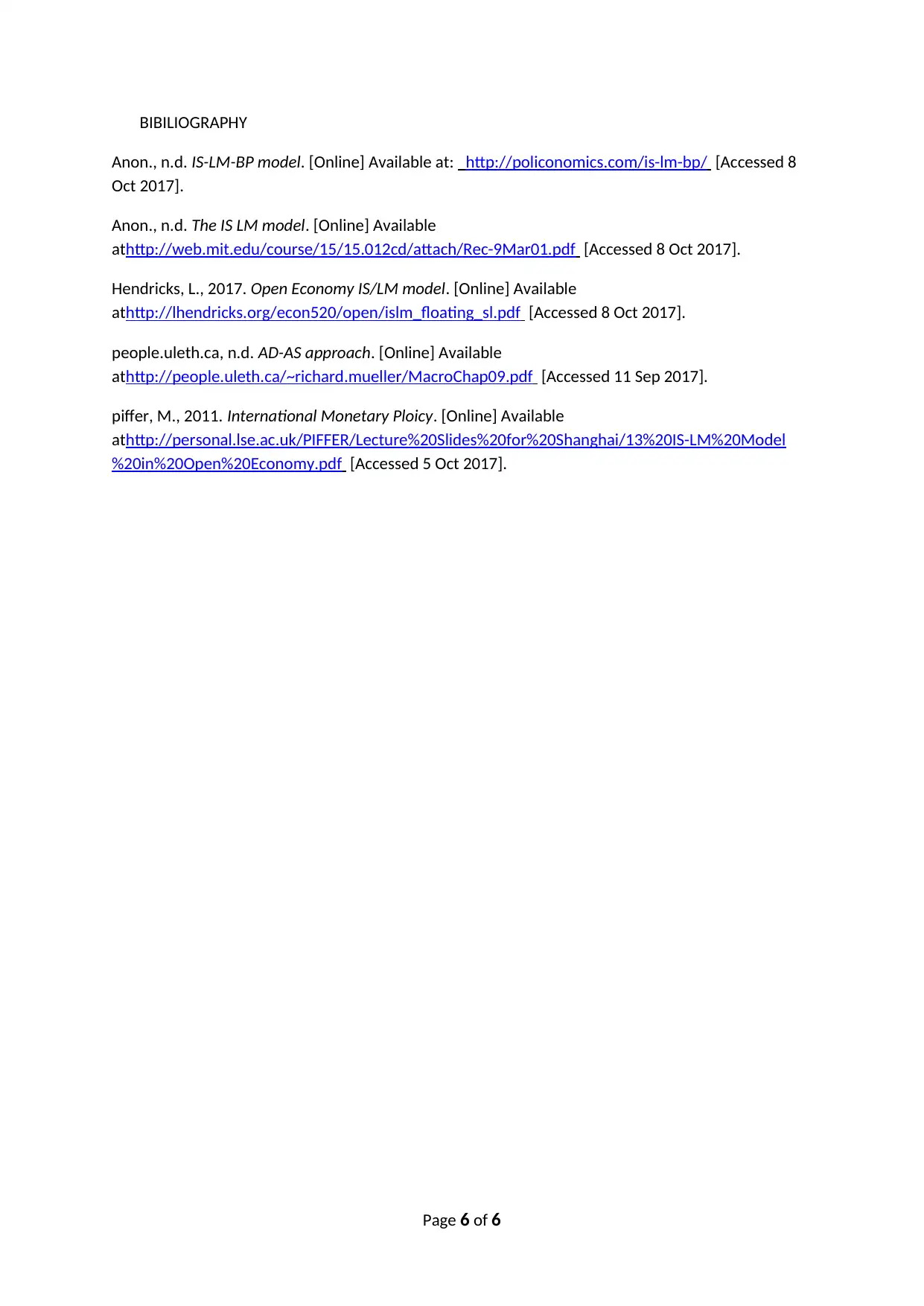
BIBILIOGRAPHY
Anon., n.d. IS-LM-BP model. [Online] Available at: http://policonomics.com/is-lm-bp/ [Accessed 8
Oct 2017].
Anon., n.d. The IS LM model. [Online] Available
athttp://web.mit.edu/course/15/15.012cd/attach/Rec-9Mar01.pdf [Accessed 8 Oct 2017].
Hendricks, L., 2017. Open Economy IS/LM model. [Online] Available
athttp://lhendricks.org/econ520/open/islm_floating_sl.pdf [Accessed 8 Oct 2017].
people.uleth.ca, n.d. AD-AS approach. [Online] Available
athttp://people.uleth.ca/~richard.mueller/MacroChap09.pdf [Accessed 11 Sep 2017].
piffer, M., 2011. International Monetary Ploicy. [Online] Available
athttp://personal.lse.ac.uk/PIFFER/Lecture%20Slides%20for%20Shanghai/13%20IS-LM%20Model
%20in%20Open%20Economy.pdf [Accessed 5 Oct 2017].
Page 6 of 6
Anon., n.d. IS-LM-BP model. [Online] Available at: http://policonomics.com/is-lm-bp/ [Accessed 8
Oct 2017].
Anon., n.d. The IS LM model. [Online] Available
athttp://web.mit.edu/course/15/15.012cd/attach/Rec-9Mar01.pdf [Accessed 8 Oct 2017].
Hendricks, L., 2017. Open Economy IS/LM model. [Online] Available
athttp://lhendricks.org/econ520/open/islm_floating_sl.pdf [Accessed 8 Oct 2017].
people.uleth.ca, n.d. AD-AS approach. [Online] Available
athttp://people.uleth.ca/~richard.mueller/MacroChap09.pdf [Accessed 11 Sep 2017].
piffer, M., 2011. International Monetary Ploicy. [Online] Available
athttp://personal.lse.ac.uk/PIFFER/Lecture%20Slides%20for%20Shanghai/13%20IS-LM%20Model
%20in%20Open%20Economy.pdf [Accessed 5 Oct 2017].
Page 6 of 6
⊘ This is a preview!⊘
Do you want full access?
Subscribe today to unlock all pages.

Trusted by 1+ million students worldwide
1 out of 6
Related Documents
Your All-in-One AI-Powered Toolkit for Academic Success.
+13062052269
info@desklib.com
Available 24*7 on WhatsApp / Email
![[object Object]](/_next/static/media/star-bottom.7253800d.svg)
Unlock your academic potential
Copyright © 2020–2025 A2Z Services. All Rights Reserved. Developed and managed by ZUCOL.





